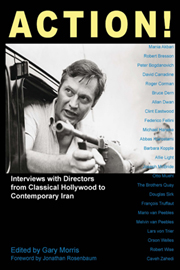Book contents
- Frontmatter
- Contents
- Foreword, by Jonathan Rosenbaum
- Editor's Preface
- Acknowledgements
- Introduction: The Art and Craft of Interviewing
- I Going Hollywood: Masters of Studio Style
- II Tickets to the Dark Side: Festival Favorites
- III Blows Against the Empire: Indie Godfathers
- IV Edgeplay: Avant-Garde Auteurs
- V Women in Revolt: Artist-Activists
- VI The Canon: Brilliance without Borders
- Contributor Biographies
Foreword, by Jonathan Rosenbaum
Published online by Cambridge University Press: 05 March 2012
- Frontmatter
- Contents
- Foreword, by Jonathan Rosenbaum
- Editor's Preface
- Acknowledgements
- Introduction: The Art and Craft of Interviewing
- I Going Hollywood: Masters of Studio Style
- II Tickets to the Dark Side: Festival Favorites
- III Blows Against the Empire: Indie Godfathers
- IV Edgeplay: Avant-Garde Auteurs
- V Women in Revolt: Artist-Activists
- VI The Canon: Brilliance without Borders
- Contributor Biographies
Summary
It's often overlooked that the revolution in film taste promulgated in the '50s and '60s by Cahiers du Cinéma (and, to a lesser extent, by Positif) was at least as much a matter of interviews as it was a matter of reviews and essays. Admittedly, the most consequential broadside by the most prominent Cahiers critic-turned-filmmaker was François Truffaut's, “Une Certaine Tendance du cinéma français” (“A Certain Tendency in the French Cinema”), which first appeared in the 31st issue (January 1954). But if that opening salvo established an important polemical position, it must be conceded that Truffaut's clinching victory came a dozen years later with Le Cinéma selon Hitchcock (1966), his book-length interview with his avowed master, published in English the following year with the simpler title Hitchcock.
“Une Certain Tendance” was at most a warning shot–a contentious article that created waves in the Parisian film world, but still a local event, appearing in an oddball monthly with a thenmodest circulation. Hitchcock, on the other hand, marked an international paradigmatic shift from the position that commercial cinema was basically a form of light entertainment to the more controversial notion that Alfred Hitchcock, the most recognizable director of light entertainment in Hollywood, was also one of the medium's most serious, accomplished, and even experimental and thoughtful artists.
Truffaut set out to prove this premise by engaging Hitchcock himself in the discussion–an undertaking requiring the services of an expert translator, Helen G. Scott, because neither speaker was fluent in the other's language.
- Type
- Chapter
- Information
- Action! , pp. vii - xPublisher: Anthem PressPrint publication year: 2009



